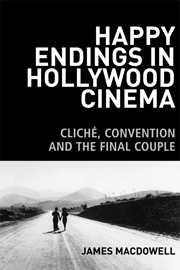3 - Happy endings and unrealism
Published online by Cambridge University Press: 05 October 2013
Summary
When the term ‘happy ending’ is spoken in Hollywood movies, it is usually being debunked for promulgating idealism in the face of life's true hardships. One of the most bitterly ironic uses of the phrase, for instance, comes in the WWII romance Waterloo Bridge (1940) when Roy (Robert Taylor), unaware that his fiancée has been forced into prostitution via a combination of economic circumstance and erroneous news of his death, tells her upon his reappearance, ‘Darling, don't cry – it's a happy ending …’; almost fifty years later, at the somber and amoral conclusion of Crimes and Misdemeanours (1989), Judah (Martin Landau) says simply that, ‘If you want a happy ending you should go see a Hollywood movie.’ Repeatedly, in all kinds of films, the term ‘happy ending’ is compared to fantasy and illusion, and contrasted to the comparative harshness of the real world.
This is the same basic pattern that tends to govern movies' uses of the term ‘happily ever after’, which will commonly be mocked for referring to a naïve, ‘fairy tale’ view of life, and romantic love in particular. Sometimes this point is made in reference to specific relationships: in The Awful Truth Lucy tells a judge during her divorce proceedings that she and Jerry ‘thought we had better get married; that way we were able to give Mr. Smith [their dog] a better home and live happily ever after – until now …’;
- Type
- Chapter
- Information
- Happy Endings in Hollywood CinemaCliche, Convention and the Final Couple, pp. 98 - 132Publisher: Edinburgh University PressPrint publication year: 2013



